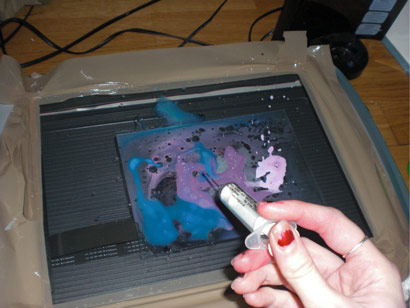
| |
| technic |
| artists |
| links |
| material |
| contact |
| home | bibliography |

Rebecca Wild's method |
"For this help page i was using a hp scanjet 3530c. It's quite an old model and i wouldn't recommend it as the best printer for doing this kind of thing. The colours created aren't as vivid as the Canon scanners tend to be.
Firstly you have to make sure you create a way that the paint won't leak into the scanner.
I vary between using a picture frame that is securely sealed [I usually seal mine with parcel tape] or I use parcel tape directly onto the scanner covering each edge. After a few scans the tape may need to be replace or reinforced so I would keep a close eye on what that is doing. Make sure there are no gaps and the tape is pushed down and in contact with the glass at all times

Now for the fun part!
I create my 'paintings' in various different ways all exploring the idea of abstract art but not in a typical sense. I explore how abstract I can make an art piece so I try to make it unpredictable what the outcome will be.
To do this I begin by pouring a liquid onto the scanner. Usually this will be water but i have tried oil, washing up liquid and various other substances in the past. In this image i used bubble solution.

I only put a small amount on,ust a drop or two, not enough to flood when the other liquids are applied. I then mix up watery solutions of acrylic paint as this gives the most vibrant colours. I find gouache and watercolour's become quite opaque which is a different effect than what i am exploring at present.

Then the next stage varies.
Sometimes I use a straw and suck up the paint and blow it out onto the scanner. Other times I use various sponges or brushes to drip or splatter paint across the scanner and other times I pour the paint in various parts and use the straw to blend them. I'm still experimenting with my practise now of looking at new and interesting ways to apply the paint to create these beautiful textured prints. For this tip page i have been using a new method of applying the paint with a syringe.


Ensure that the scanner is on an even surface otherwise the 'painting' will start to run and this can cause problems if it seeps over the edge into the scanner mechanism.

Then it's just a case of pressing scan! I normally use MP Navigator EX 1.0 for my scans on my Canon scanner. Usually 300dpi or higher and on the 'magazine' setting as this gives the best contrast and colour vibrancy.
For my hpjet i used a basic free scan software called FreeKapture. The results came out a bit clouded due to the age of the scanner so i have enhanced the exposure on these pictures for maximum vibrancy
You can also add other substances to the paint. For this i have used glue, ink, and bubble solution.


result :

Afterwards I can add more to it or remove the paint and start again!
Another way of doing this is by my new method with involves a sheet of glass.This glass is applied directly ontop of the paint on the scanner to create a vaccuum and seal the paint inside.


This also creates air pockets which i feel look effective when scanned


It also means you can work ontop of the glass to create more depth or a different colored background



or you could place the glass onto the scanner first and then paint ontop to keep your scanner a little cleaner of paint.

The choice is up to you :)"
Rebecca Wild
• Chris Staebler's
layering method >
• Jaime Ruas's
liquid painting method
• Patri Feher's
detailed method >